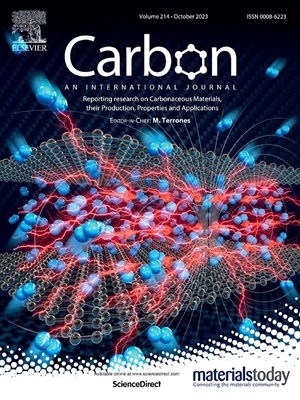Rapid joule-heating-driven synthesis of FeCo alloy nanoparticles embedded in porous carbon nanorods for electromagnetic wave absorption
IF 10.5
2区 材料科学
Q1 CHEMISTRY, PHYSICAL
引用次数: 0
Abstract
Magnetic carbon-based composites exhibited enhanced electromagnetic wave (EMW) absorption performance; however, their fabrications through conventional annealing methods need a relatively long time. Herein, FeCo alloy nanoparticles (NPs) embedded in porous carbon nanorods are synthesized through a rapid Joule heating method within 10 s. The ∼170-nm-FeCo NPs encapsulated in graphene layers are embedded in porous carbon nanorods with a diameter of around 500 nm. Density functional theory (DFT) calculations and experimental results show that the orbital hybridization of Fe and Co atoms can adjust the d-band center and induce magnetic coupling effects, while the charge redistribution at the interfaces between FeCo alloys and the graphene layers enhances dielectric loss. In addition, the structural features, including porous and one-dimensional structures, synergistically improve EMW absorption performance. Consequently, the optimal FeCo-CNRs achieve an effective absorption bandwidth (EAB) of 6.08 GHz at a matching thickness of only 1.9 mm, outperforming single counterparts and most of the reported magnetic carbon-based absorbers. This work aims to provide a rapid approach for developing magnetic carbon composites for high-performance EMW absorption.

快速焦耳加热合成嵌入多孔碳纳米棒的feo合金纳米颗粒用于电磁波吸收
磁性碳基复合材料具有增强的电磁波吸收性能;然而,通过传统的退火方法制备它们需要相对较长的时间。本文采用快速焦耳加热方法,在10 s内合成了嵌入多孔碳纳米棒中的FeCo合金纳米颗粒。包裹在石墨烯层中的~ 170纳米feco纳米粒子被嵌入直径约500纳米的多孔碳纳米棒中。密度泛函理论(DFT)计算和实验结果表明,Fe和Co原子的轨道杂化可以调节d带中心并诱导磁耦合效应,而FeCo合金与石墨烯层界面处的电荷重分布增加了介电损耗。此外,多孔结构和一维结构等结构特征协同提高了EMW吸收性能。因此,在匹配厚度仅为1.9 mm的情况下,最佳的fco - cnr实现了6.08 GHz的有效吸收带宽(EAB),优于单个同类材料和大多数已报道的磁性碳基吸收材料。本研究的目的是提供一种快速开发高性能EMW吸收磁性碳复合材料的方法。
本文章由计算机程序翻译,如有差异,请以英文原文为准。
求助全文
约1分钟内获得全文
求助全文
来源期刊

Carbon
工程技术-材料科学:综合
CiteScore
20.80
自引率
7.30%
发文量
0
审稿时长
23 days
期刊介绍:
The journal Carbon is an international multidisciplinary forum for communicating scientific advances in the field of carbon materials. It reports new findings related to the formation, structure, properties, behaviors, and technological applications of carbons. Carbons are a broad class of ordered or disordered solid phases composed primarily of elemental carbon, including but not limited to carbon black, carbon fibers and filaments, carbon nanotubes, diamond and diamond-like carbon, fullerenes, glassy carbon, graphite, graphene, graphene-oxide, porous carbons, pyrolytic carbon, and other sp2 and non-sp2 hybridized carbon systems. Carbon is the companion title to the open access journal Carbon Trends. Relevant application areas for carbon materials include biology and medicine, catalysis, electronic, optoelectronic, spintronic, high-frequency, and photonic devices, energy storage and conversion systems, environmental applications and water treatment, smart materials and systems, and structural and thermal applications.
 求助内容:
求助内容: 应助结果提醒方式:
应助结果提醒方式:


